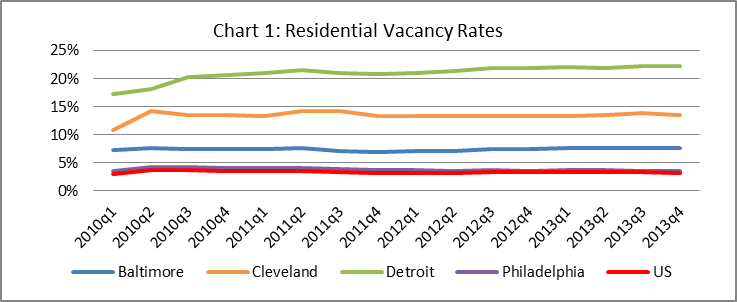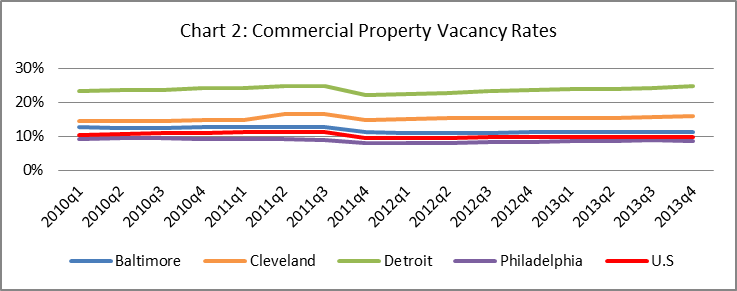Redefining Rustbelt: Opportunities for city revitalization and educational reform
The Federal Reserve Banks of Richmond, Cleveland, Philadelphia, and Chicago-Detroit Branch recently held a videoconference on “Land Use Planning: Aligning Investment with Vision” to share strategies related to blight mitigation, the management of vacant land and the development of commercial corridors. This was the third exchange between experts and stakeholders in a series between the four cities on strategies to attract residents and investments.
Each of the cities represented at the videoconference has confronted high numbers of foreclosed and abandoned homes and commercial vacancies that have resulted in widespread blight. Data from the US Postal Service (charts 1 and 2) shows little improvement in vacancy rates in these cities since 2011. For Detroit, the rate of residential vacancies is four times that in the US, and the rate of commercial property vacancies is more than double the national rate. Strategies to address abandonment, blight, and declining commercial corridors as such have been integral to these cities’ efforts to stabilize population and attract investment. The videoconference discussion focused on five particular land use strategies.


Five Elements of a Comprehensive Approach to Land Use Strategies
(1) Data collection
Data collection and consolidating information allows cities to be more systematic about removing blight. It gives city agencies information about where to target abatement actions. A better understanding of the inventory also makes it easier to acquire privately-owned, tax-delinquent properties to assemble larger tracts that can be repurposed and redeveloped. Some specific efforts noted during the videoconference included:
- The Blight Task Force, in Detroit, which has organized teams to photograph parcels and document the characteristics of each property. This work is helping to develop a systematic and sustainable blight-removal framework for the city.
- A city of Cleveland program, through which the Cleveland fellows have developed a framework that prioritizes properties for demolition based on predetermined neighborhood- and property-specific factors. Relevant property data is fed into a transparent process for determining demolition priorities.
- A city of Philadelphia program, under the Philadelphia Redevelopment Authority, that makes vacant lot prices available to the public and publishes disposition policies on how to buy (in some cases, discounted) city-owned property.
- A Baltimore city contract with TRF (the Reinvestment Fund) for a market value analysis that helps the city understand its market dynamics and develop strategies to rebuild and stabilize distressed real estate markets.
(2) Zoning ordinances
All the cities have established some form of compliance-based code enforcement for abandoned property. The city of Philadelphia was noted for its successful anti-blight zoning ordinance. An analysis of the anti-blight initiative found that places where targeted enforcement took place had property sale prices roughly 30 percent higher on average, and fewer tax delinquencies, than places where no intervention of this type occurred.
(3) Land banks
Land banks allow the public sector to remove excess supply from the market, which in turn helps to stabilize property values. Land banks can also facilitate better analysis of where aggregating parcels can have an impact on neighborhood stabilization, which can accelerate overall real estate market revitalization compared with strategies involving piecemeal transfer or sale of land. Over the course of the meeting, representatives discussed various issues pertaining to the pros and cons (such as the added costs of property maintenance), and noted the following:
- The Cuyahoga County land bank (Cleveland) is one of the largest and, based on the volume of acquisition, demolition, and redevelopment (and other factors), most effective land banks in the country.
- Several land banks in the Detroit metro area are in the process of being merged together.
- Philadelphia passed legislation for the creation of a land bank in December 2013. The Philadelphia land bank will offer a streamlined process to people who apply for property, in contrast to the various agencies that follow different policies and systems for land acquisition and re-use.
(4) Green spaces and “un-development”
Traditionally, cities have viewed open spaces as public amenities and potential gateways to improve the appeal of neighborhoods. More recently, cities are relating open spaces to environmental sustainability. Cities that have lost substantial population have come to look at city landscapes from an ecological perspective, pursuing so-called “un-development” strategies that derive value from land otherwise perceived as unproductive. The aim is to transform open spaces for uses like storm water management and urban agriculture. Representatives discussed and highlighted some of the initiatives and issues related to green space:
- Baltimore’s Parks and People Foundation piloted an urban forestry initiative in the 1990s with help from the US Forest Service.
- More recently, the city of Cleveland moved from the practice of holding onto residential parcels (in their land bank) to selling to developers, and encouraging home owners to expand side yards and double their residential lots, if adjacent vacant properties are not located in an area targeted for development.
- In Baltimore, the city’s Office of Sustainability in the City Department of Planning developed the “Growing Green” initiative, which focuses on reusing vacant land, including the greening of neighborhoods. The Green Pattern Book, spearheaded by this same office, serves as a guide to encourage the planning and implementation of different green uses for vacant land.
- Economic developers in Detroit are also developing an environmental plan in conjunction with their blight remediation and demolition strategy.
(5) Business corridor development
The development of neighborhood business corridors is another strategy that cities are pursuing to mitigate blight. Some of these strategies cover multiple neighborhoods, involving investments in transportation routes to connect otherwise marginal areas with the economic hubs of a city. Cities are also deploying corridor strategies in middle market areas, where attention to a few storefronts is intended to shift the market trajectory for the surrounding neighborhood. Neighborhoods with unique architecture or historic character are also targeted for business corridors. These places can encourage creativity and provide a sense of “fun.” Developers hope to attract artists and a mix of tenants into these neighborhoods. Some of the discussions noted the following:
- Cleveland has invested in streetscape and in bus rapid transit to better connect businesses. It has reconfigured portions of West Shoreway freeway into an urban parkway, offering opportunities for the development of vacant land. Another project, “Opportunity Corridor,” connects impoverished parts of Cleveland to freeways and to the University Circle.
- In Detroit, Revolve Detroit at the Detroit Economic Growth Corporation is focusing on two business districts. New occupants include pop-ups and jury-selected artists.
- Philadelphia is working on corridor development to fill storefronts with a combination of art and retail.
- Baltimore looks to bring in restaurants and other food-based businesses to encourage visitors and newcomers to go into different neighborhoods.
Conclusion and takeaways:
With respect to any of the strategies discussed during the videoconference, participants emphasized the importance of getting input from community residents. Openness and transparency allow the community to feel ownership and participate in the process. Baltimore’s experience with large-scale demolitions in East Baltimore offers an example of successful community engagement. Its demolition protocol was developed as a collaborative effort that brought the local community into the entire process – from site demolition, to the cleaning-up of a brownfield, to the design of the first new school in Baltimore city in 20 years. In a similar spirit, the Detroit Economic Growth Corporation and Revolve Detroit have engaged neighborhood residents, local business owners, and property owners to build plans along designated business corridors.
A related message from the videoconference exchange was that blight elimination should be people-focused, and intended to improve the quality of life and bring about new opportunities for residents. The experience in the East Baltimore Revitalization Initiative underscores this point. Families relocated during that project moved into homes valued at considerably more than those they had vacated. These families, with the support of The Annie E. Casey Foundation, were provided an asset that could then potentially alter their lives for the better.
An overarching theme of the conference was that cities should make strategic decisions about where to demolish and redevelop, but also put in place programs and policies to encourage overall economic redevelopment. These include improvements in education, job training, and job creation, organically or by attracting and incenting employers.








